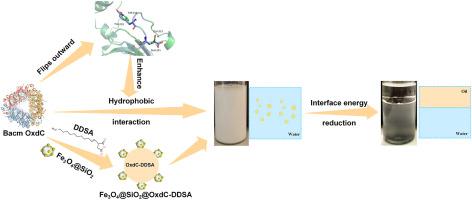Chemosphere ( IF 8.1 ) Pub Date : 2022-09-24 , DOI: 10.1016/j.chemosphere.2022.136595 Ning Hou 1 , Xin Zhao 1 , Ziyi Han 1 , Xinxin Jiang 1 , Yongping Fang 1 , Yun Chen 1 , Dapeng Li 1

|
The inability to demulsify oil-in-water emulsions via green and efficient processes is a challenging problem in many industrial processes. As a novel biodemulsifier, protein demulsifiers display excellent dispersibility and stability, but their demulsification mechanisms are not clear, which severely restricts their large-scale production and application. In this study, the demulsification mechanism of the high-efficiency protein biodemulsifier oxalate decarboxylase (Bacm OxdC), which is secreted by the Bacillus mojavensis XH1 strain, for an oil-in-water emulsion was analyzed. The results showed that Bacm OxdC was spontaneously adsorbed at the oil-water interface and turned its hydrophobic amino acids outward to increase its hydrophobicity and break the emulsified system. Furthermore, it effectively reduced the oil-water interfacial tension and interfacial film strength, thereby reducing the oil-water interfacial energy and finally enabling demulsification. To further improve the demulsification efficiency and reusability, Fe3O4@SiO2@OxdC-DDSA was prepared. This method provided a magnetic response for Bacm OxdC and enabled efficient demulsification. The demulsification rate of Fe3O4@SiO2@OxdC-DDSA reached 98.1% at 24 h, which was 30.7% higher than that of the original Bacm OxdC. After three cycles, the demulsification rate still reached 89.3%, proving it has excellent recyclability. This work is the first study on the demulsification mechanism of protein biodemulsifiers and provides useful insights into the demulsification mechanism of biodemulsifiers for oil-in-water emulsions. In addition, a promising high-efficiency modification technique for protein biodemulsifiers was proposed, which provided information for the development of biodemulsifiers for oil-water separation.
中文翻译:

十二碳烯基琥珀酸酐改性草酸脱羧酶负载磁性纳米Fe3O4@SiO2用于水包油乳液的破乳
在许多工业过程中,无法通过绿色和高效的工艺破乳水包油乳液是一个具有挑战性的问题。蛋白质破乳剂作为一种新型的生物破乳剂,具有优异的分散性和稳定性,但其破乳机理尚不明确,严重制约了其大规模生产和应用。本研究探讨了莫哈文芽孢杆菌分泌的高效蛋白质生物破乳剂草酸脱羧酶(Bacm OxdC)的破乳机制。分析了用于水包油乳液的 XH1 菌株。结果表明,Bacm OxdC在油水界面自发吸附,将疏水氨基酸向外翻转,增加疏水性,破坏乳化体系。此外,它有效地降低了油水界面张力和界面膜强度,从而降低了油水界面能,最终实现破乳。为了进一步提高破乳效率和可重复使用性,制备了Fe 3 O 4 @SiO 2 @OxdC-DDSA。该方法为 Bacm OxdC 提供了磁响应并实现了高效破乳。Fe 3 O 4 @SiO 2的破乳率@OxdC-DDSA 在 24 小时达到 98.1%,比原始 Bacm OxdC 高 30.7%。三个循环后,破乳率仍达到89.3%,证明其具有优良的可回收性。这项工作是对蛋白质生物破乳剂破乳机理的首次研究,为水包油乳状液中生物破乳剂的破乳机理提供了有益的见解。此外,提出了一种很有前景的蛋白质生物破乳剂高效改性技术,为油水分离生物破乳剂的开发提供了信息。















































 京公网安备 11010802027423号
京公网安备 11010802027423号